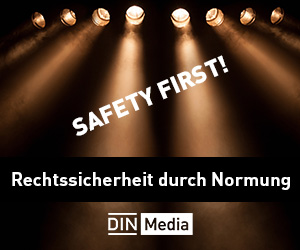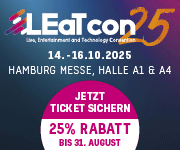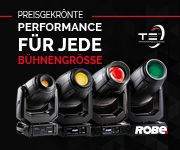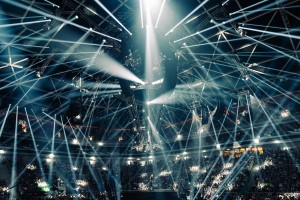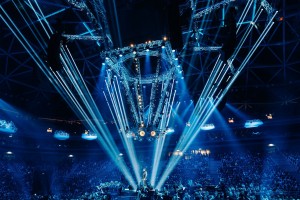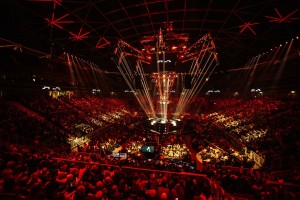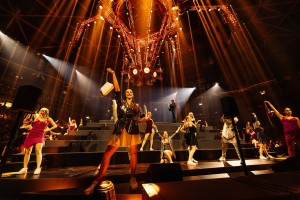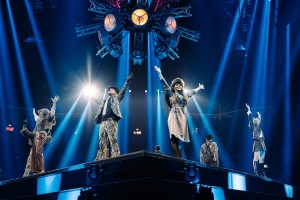Aktuelle News & Schlagzeilen
Lado Bizovicar’s “Slovenska Muska” event lit with Robe
Slovenian writer, actor and TV personality Lado Bizovicar presented the 2024 “Slovenska Muska” event, staged at Ljubljana’s Stožice arena, the first time in the venue’s history that a 360-degree show had been presented, which bumped up the capacity to 13,000, with every seat sold.
The production and lighting design was created by Crt Birsa of design studio Blackout and Greta Godnic and recorded for broadcast. Birsa utilised 355 Robe lighting fixtures in the 500+ luminaires on the rig, from the high-powered Forte to the scenic Patt 2013 plus seven other types of Robe product, all supplied by rental specialist Event Lighting from Ljubljana.
At the heart of the production design was an elaborate metal structure, the top part of which resembled a giant multi-level spider crawling through the roof area. This structure incorporated the venue’s video scoreboard with the surfaces used for production video during the show, and contesting it presented multiple rigging challenges requiring some serious brain-teasing, bridling and mathematics to get everything in the right places.
It was the first time that Birsa had worked with this artist, originally asked onboard due to his experience in delivering arena and stadium shows. He and set designer Greta Godnic devised a unique look and style for the show to get the artists closer to fans and look as good live as it did for the multi-camera shoot directed by Nejc Levstik.
Bizovicar riffed through a light hearted A to Z take on Slovenian musical talent, with each letter of the alphabet corresponding to a genre or a related music artist, e.g. R for Rap, M for musical, A for artist (e.g. Avsenik) etc., as he cracked jokes, sang songs and welcomed a string of guests onstage, from a symphonic orchestra to dancers, musicians and singers all wrapped up in a fast paced all-action romp.
The giant trussing spider in the roof had eight right-angled legs stretching out into the roof void from a 10-metre square box truss which provided ideal positions for high level audience lighting. There were additional trusses at each side of the arena loaded with more ambient and the main key lighting fixtures.
The bottom part of the spider structure sat below the large arena video cube and featured a 7-metre square box truss connected to 8 vertical “fingers” trusses running horizontally down, joined together in the centre immediately above the stage.
Stožice’s winter snow loading meant that the already tight weight loadings were further restricted, so trussing was juggled with the points needed to facilitate the eight PA arrays. Some trusses were deaded off and motors removed to save weight and meet requirements without compromising the design. With no time available for a pre-rig and two special lifts in the venue that must be used for accessing the roof structural beams, it was imperative that all metalwork went straight into the roof as envisioned in a carefully calculated risk-to-art ratio.
Twelve Fortes were used for the key lighting, with three fixtures each rigged on four “ambient” trusses around the edge of the arena. The central Forte on each of these was on one of two RoboSpot systems, so front/back and left/right key lights could be alternated, and specials worked in unison to pick up Bizovicar and guests.
Eighty Robe LEDBeam 150s were on the rig with 24 on the floor outlining each side of three stairways accessing the stage. The fourth side of the stage was occupied by an accompanying musician who was surrounded by eight Pointe luminaires. Another 32 LEDBeam 150s on the eight vertical truss fingers and 24 on the ends of six spider legs offered high beams and other eye candy effects. Another Blackout client, the band Laibach, were gigging at the same time, so between this and their show it is likely that all the LEDBeam 150s in Slovenia were in use.
Another 24 LEDBeam 350s were deployed on the left and right ambient trusses where they were used for washing the audience. Six MegaPointes on the spider legs were outrigged on pipes, part of 72 of these fixtures which constituted the next biggest group of Robe fixtures after the LEDBeam 150s. Forty-eight MegaPointes in total were used at the top of the eight spider legs - six per leg - and another 24 - six a side - on the four sides of the 10-metre box truss.
The balance of 32 Pointes were used on the four ambient/audience trusses, eight units on each truss, with 59 ParFect 100s for truss toners covering all the fingers and spider legs. Sixteen Robe Paintes were positioned on the floor around the stage. “I needed a spot that could be close to the artists and the audience”, notes Birsa. It was the first time he’d used Paintes, which he thought were “very nice mid-range fixtures”.
A total of 63 Robe Spiider LED wash beams were utilised, running in three different modes, with five each around the sides of the smaller square truss, three covering the top section of each spider leg, one as static back light for guest musicians, and sixteen on the front and back ambient trusses for audience lighting. The final two were ensconced under the stage.
At the centre of the stage was a hydraulic lift, which started the show in the down position (with Bizovicar standing on it to make his entrance) so the under-stage Spiiders lit the void that was filled with smoke for the entrance sequence. The Patt 2013s were positioned on the end of the legs in the higher position, with some similar looking scenic fixtures at the bottom of the fingers.
Tight timing necessitated an amount of pre-vizzing, although it’s quite a conundrum to pre-programme a 360 degree show on a flat screen, so calculated adaptation was needed once on site. Birsa used feeds from four cameras set up at the top of the lower tribunes on each side of the venue to help him see the stage from all perspectives.
He worked with his Blackout colleague Klemen Krajnc who took care of running all the show key together with the under-stage lights, guest artist back lighting and the battery of fog machines. Everything else was controlled and run by Birsa. Krajnc maximised the Fortes’ shuttering to contain light spillage and ensure the audience were not irritated or distracted, which in an in-the-round scenario is as challenging as it is essential.
Rok Ložar from B-Projekt was the production manager co-ordinating the teams to make this event happen. Mitja Zupancic created rigging plots and minutely detailed rigging logistics so that the Prozvok riggers could build and install the rigging and trussing accurately. On top of this, Andrej Testen, a crew chief from Event Lighting, assembled a team to put the whole lighting system together.
(Photos: Marko Alpner/Lovro Rozina/Jani Ugrin/Anže Vrabl)
SCHLAGZEILEN
news archiv
suche
© 1999 - 2025 Entertainment Technology Press Limited News Stories

